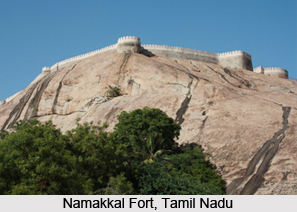 Namakkal Fort was built by Tipu Sultan. Tipu Sultan, also known as the Tiger of Mysore, was the ruler of the Kingdom of Mysore from 1782 to 1799. he was the eldest son of Sultan Hyder Ali of Mysore. Namakkal fort has the worship place for both Hindus and Muslims. Till date both the communities visit this place for worship.
Namakkal Fort was built by Tipu Sultan. Tipu Sultan, also known as the Tiger of Mysore, was the ruler of the Kingdom of Mysore from 1782 to 1799. he was the eldest son of Sultan Hyder Ali of Mysore. Namakkal fort has the worship place for both Hindus and Muslims. Till date both the communities visit this place for worship.
Namakkal fort is situated on the summit of Namagiri Hills. It is one of a few naturally strong forts steeped in history of the district. The fort was under Mysore until it was captured by the British East India Company in 1769. After that it was retaken by Hyder Ali. After a few months this fort was captured again by the British in 1792. It contains the ruins of a Lord Vishnu temple dedicated to Ethirili Perumal with the inscription of Sadaiyavaraman Sundhara Pandiyan.
Namakkal fort covers an area of one and a half acres of flat surface and is accessible from the southwest by a flight of narrow steps. The mark is the white and red graphic symbol of Vishnu. The representation is depicted with two white and one red vertical line. The people who believe in Vaishnavism usually wear the symbol on their forehead. On the hills and hillocks of Salem District where Vishnu Shrines are situated, there are large "namams" are painted on the nearby boulders. On the "Nama Malai", the northern spur (693 meters high) of the "Jarugu Malai" range, a conspicuous "namam" (mark) is painted on a rock on the hill side near a small shrine of Lord Vishnu. Each of the two prongs that is representing the feet of Lord Vishnu of the namam is about 40 feet long and 6 edges. This is clearly visible from all parts of the city.
There are two rock-cut cave temples dedicated to Ananthasayi and Narasimha Swamy. These are located on the eastern and western sides of the rock. The temples and the images of Gods within the temples were hewn out of the living rock. As they grow naturally out of the living stuff of the earth. It is sustained by the power of the rock and hill; these shrines are esteemed higher than the ordinarily built temples.
The rock also contains eight holy water springs locally called the Teerthams. It is the biggest of which is the Kamalayam (Home of the Lotus) sacred to the Goddess Namagiri Amman. It was the chief source of water supply for the town until water from the Kaveri River was brought. The other Theerthams are Anantharama Theertham, Narasimha Theertham and Serbha Theertham. Another list of holy Teerthams includes Hanuman Theertham, Lakshmana Theertham, Lakshmi Therrtham, Narayana Theertham, Rishi Theertham, and Seetharam Theertham.



















